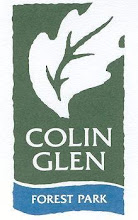The Colin area has developed over the last 200 years. Throughout these years the Colin Glen has had several landowners and uses.
The glen has been used for brickworks, linen, game hunting, a landfill site and most recently it is being used as a Park, which today gets used by 1000's throughout the year such as members of the community, schools and college's and tourists.
The Park itsself has been described as Belfasts "GREEN LUNG" and provides a tranquil and much needed greener area for generations yet to come. This has been achived by dedicated staff, local communities and volunteer programmes.
The name Colin comes from the Irish word "Collan" meaning a Great Height or High Ground which gives the name to Colin Mountain and also Colin River.
The Colin River rises on the slopes of Black and Divis mountains and flows downstream past Colin mountain meandering its way through the Glen to join up with the lagan at Sir Thomas and Lady Dixon park near Dunmurry. There are also a number of small tributaries that join up with the river at different points along its course.









-email.gif)
